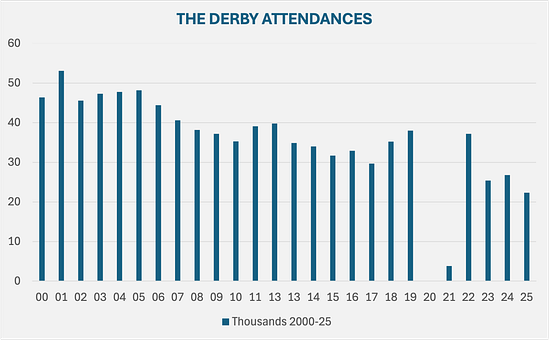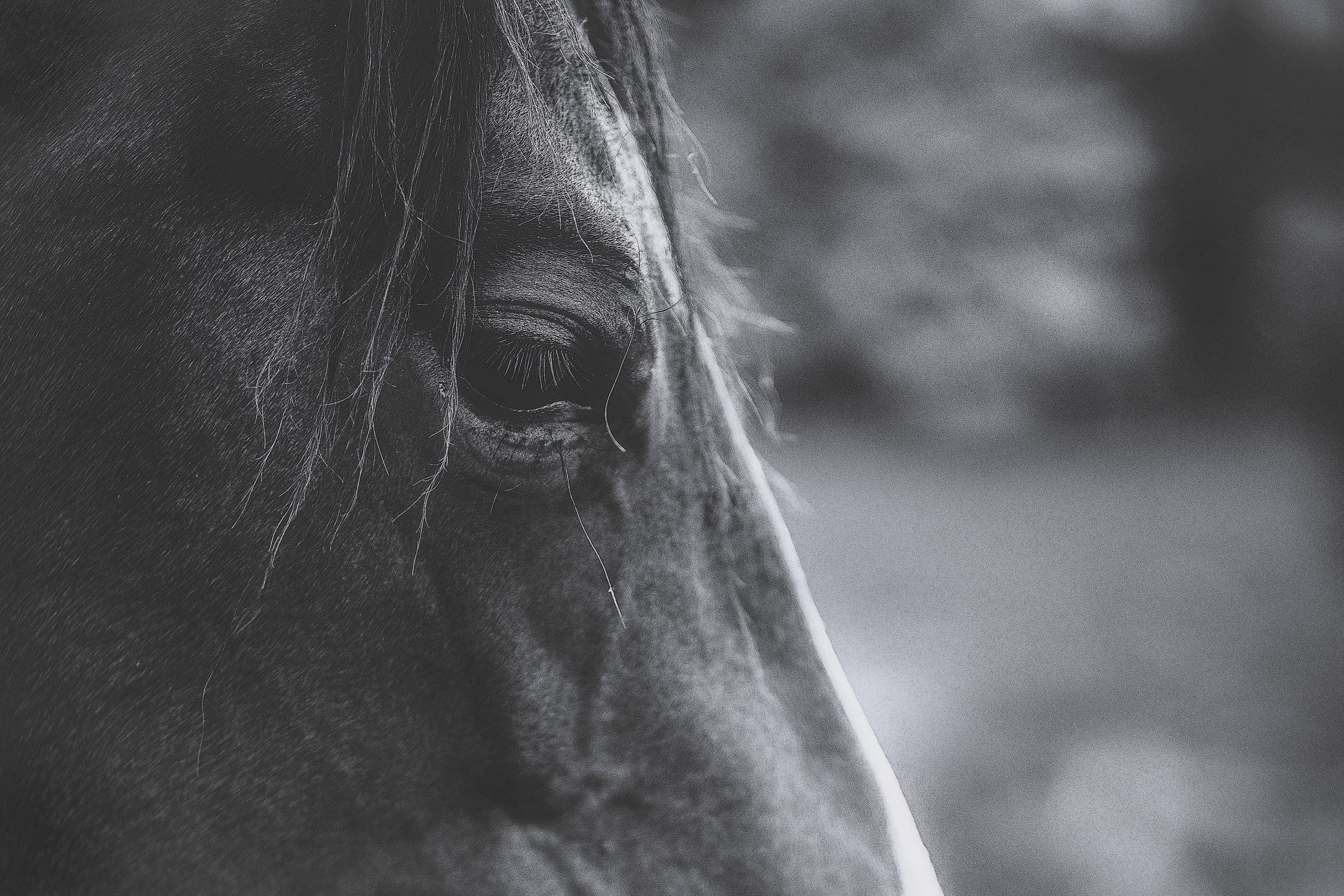I didn’t know The Derby was on Saturday until the next day when I spotted a newspaper montage of flamboyant fashion photos of some who had made it to Epsom Downs.
Too late for me to join the 1.3 million who are reported to have tuned into ITV for the meeting. The Jockey Club, owner of the racecourse, will need to get a hefty proportion of these viewers up off their sofas if it is to reverse the dwindling crowds at this iconic race.
At the start of this millennium, Derby Day paying attendances typically bobbed around at just under 50,000. A free view from Epsom’s famous hill roughly doubled overall numbers at the course – essential for bookies’ returns. This year, there were only 22,312 ticketed entries. Social media reports suggest crowds on the hill were similarly sparse by heyday standards, not helped by a yellow weather warning.

Data: Horserace Betting Levy Board
Followers of the turf are bemoaning the slump in the Derby’s appeal, citing high ticket prices and poor promotion. The longest in the tooth even call for the nation’s premier flat race to return to the Wednesday berth it occupied until 1994, although reverting would require tomorrow’s generation of race lovers to bunk off school to get a taste of the action. Anyway, the data does not support the argument that the switch of days sowed the seeds of decline.
Sport inc. has flagged the challenge of falling race-goer numbers at both the Cheltenham Festival and the Grand National in recent months. Joining his course counterparts in promising a thorough review, Jim Allen, general manager at Epsom, told the Racing Post:
“I’ve seen things I’d like to change and the plan going forward is to analyse the performance of every enclosure and structure. Everything is on the table.”
Jim Allen
Worthy, and essential, though such inquests might be, they are unlikely to solve the bigger problem of racing’s ebbing place in the British public’s social calendar. The solutions posed by die-hard supporters might make a marginal difference, pulling in paying punters who know the sport but are deterred by high prices, but it is the casual follower who makes the economic difference at pinnacle events.
Advance ticket prices for the 2026 Derby range from £37 to £99 for adults. You’ll pay significantly more if you want to wait to see next June’s weather forecast before committing your wallet. Unless the sport finds better ways to reach a wider audience, you can be sure that the prices required to shift 40,000+ tickets once more are significantly lower than those currently on offer.
As I flagged last week, football is putting the squeeze on a wide range of sports, including horse racing. Personally, I wouldn’t have tuned into Andorra v England if you’d paid me (and that’s not with the benefit of hindsight!), but the prospect will have diverted the attention of some possible punters.
63,278 nevertheless turned up at Wembley for the Challenge Cup Final on Saturday, though. This a competition that happens to share a title sponsor with the Derby and was taking place when the starting gates went up at Epsom. Rugby league has its own attendance issues, but seems to have solidified attendances at its premier event. Ticket prices starting at twenty quid can only have helped.
Hard though it is to compare product offerings across sports that are so fundamentally different, organisers must ask themselves exactly what it is that others are giving spectators for their money. The action at a race meeting tots up to just a handful of minutes – hence the need to emphasise the pageantry and sense of occasion during the lengthy lulls (as well as the range of drinks available at the bars).
Unfair to compare this product directly to the five hours plus that Carlos Alcarez and Jannick Sinner served up at the French Open, but most leading sports do hold out the promise to ticket buyers of big blocks of action (albeit of admittedly unknown quality). Think a day at the golf, an afternoon of track & field, a couple of hours of F1, an evening of T20 cricket, and of course football’s regulation 90 minutes.
Don’t forget the competition from participation events, either. Next year’s Surrey Half marathon costs £42 (plus £12 if you’d like an event t-shirt), or an hour’s hire of an Epsom panel court would set you back £80 this coming Saturday. Both have scarcity value in different ways, and are charging what their respective markets will (currently) bear.
A wide range of sporting promoters have learned the laws of supply and demand the hard way. Too many have looked enviously at rivals’ events and assumed that demand will be relatively robust in the face of rising prices, that core fan bases will wear dearer tickets with a muted grumble and casual attendees will assume that published prices are the ‘right’ ones because they align with other sports. Wrong.
The market clearing price for the men’s final at Wimbledon, a FIFA World Cup final or, say, Olympic gymnastics will always be higher than asked. But organisers feel some obligation to tie them to their wider event portfolio’s price structure. That and a recognition that a scramble for scarce tickets has brand value (although the grumbles of Australian cricket fans trying to buy Ashes tickets last week highlights the associated reputational risk).
A day at the races will likely never have true scarcity value, such are the sizes of the crowds that courses can accommodate. If the sport is to have a vibrant future, it not only needs to lower its price points significantly, but also rework its offering, enveloping heritage in modern trappings. It will take time to restore the premium status of racing’s flagship meetings. Only then might it be certain of retaining their status in the sporting calendar.
Padel bingo
Try spotting a CEO bio, PR puff piece or appointment announcement these days without a reference to padel. And yet tales of frenzies to secure court bookings are a thing of the past. Check a random selection of operators’ websites and you’ll find plenty of slots, even at short notice. Looks like supply has at last caught up with swelling demand – possibly outstripping it for now. That £80 an hour booking fee may come under downward pressure. Too early to call peak padel, but don’t be surprised to see some financial distress among those who have scrambled to build capacity at up to £80,000 a court plus, of course, the cost of buying or leasing land.
Homespun philosophical hokum, inappropriate 19th hole jokes, Owen Wilson and a banging soundtrack for viewers of a certain age (Baba O’Reily anyone?). What’s not to like about Apple TV’s Stick, the streamer’s comedy about a golfing prodigy and the washed-up pro who takes him on tour? Cheese on a stick. I’ve not swung a club in anger for a couple of decades, but I’m hooked.
This article was originally published by Sport Inc.








